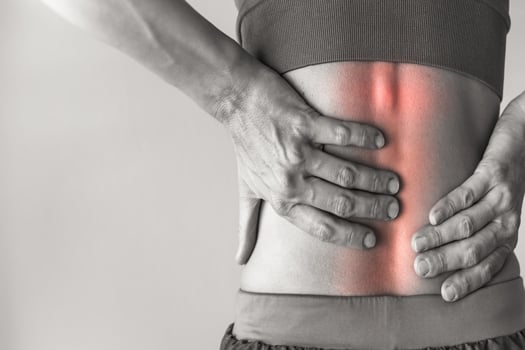
Inflammation is a common issue with herniated discs. In fact, it often contributes to the pain associated with herniation, which occurs when inner disc material extends through the outside shell of a spinal disc. This article offers suggestions for reducing inflammation of a herniated disc.
Apply Heat
A good starting point for alleviating spine pain caused by a herniated disc is to apply heat to the affected area. You can avoid skin irritation or burns by using a heating pad, taking a warm bath or shower, or using heat gel. The purpose of heat is to speed up the healing process by increasing circulation. This indirectly reduces inflammation by minimizing the body’s production of certain chemicals and processes that contribute to tissue swelling.
Apply Cold
A more direct way to reduce inflammation is to use cold therapy. Ice immediately minimizes tissue swelling by easing inflamed muscles or other soft tissues affected by a herniated disc. As with heat applications, do not apply ice directly to the area. Instead, use an ice pack or cooling gel.
Eat Foods that Naturally Ease Inflammation
The foods you eat on a daily basis can also affect inflammation around a spinal disc. Therefore, another effective way to minimize tissue swelling related to a herniated disc is to adjust your diet and eat foods that naturally ease inflammation. This includes foods such as:
• Leafy green vegetables
• Olive oil and similar healthy oils
• Almonds and walnuts
• Salmon, mackerel, and other fatty fish
• Berries
Another way to keep herniated disc–related inflammation at bay is to avoid foods that tend to make inflammation worse. Foods that fit into this category include refined carbohydrates, carbonated beverages, fried foods, and red meat.
Exercise
It is not always easy to exercise if you are dealing with spinal disc pain. However, there are some forms of exercise you can safely do to reduce inflammation. Exercise can have this effect because of the chemicals released in the body while exercising. These include "feel-good" hormones called endorphins that reduce the sensation of pain. Forms of exercise that may be beneficial for inflammation reduction include:
• Water-based exercises such as water aerobics and swimming
• Gentle forms of exercise like yoga and Pilates
• Stationary bike use
• Gentle stretching or modified stretches (e.g., seated hamstring stretches, sciatica stretches)
See What Your Doctor Has to Say
Get input from your physician or a spine specialist and determine if your discomfort is actually from a herniated spinal disc. For instance, you may experience similar symptoms due to a strained muscle in the same area. You will also benefit from treatment recommendations that can complement the other remedies suggested above.
If you have a herniated disc that is not responding to conservative treatment, a discectomy may be discussed and potentially recommended. Although this is generally a very successful procedure, having a large hole in the outer ring of the disc more than doubles the risk of needing another operation. A new treatment, Barricaid, is a bone-anchored device that closes this hole, and 95 percent of Barricaid patients did not undergo a reoperation due to reherniation in a 2-year study timeframe. This treatment is performed immediately following the discectomy—during the same operation—and does not require any additional incisions or time in the hospital.
If you have any questions about the Barricaid treatment, ask your doctor or contact us at 844-288-7474.
For full benefit/risk information, please visit: https://www.barricaid.com/instructions.


Comments